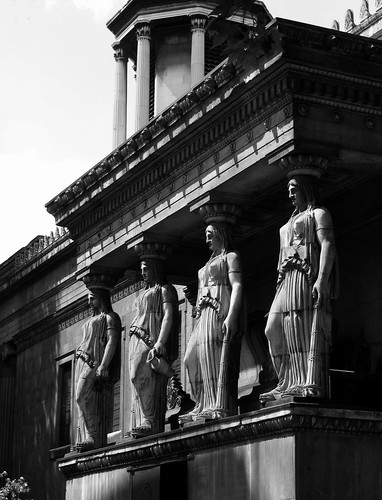Monday, 16 May 2011
A Pagan Place
William Railton's teacher, William Inwood, seems to have had a patchy career as an architect. According to the Dictionary of National he was born in around 1771, son of the bailiff at at Kenwood.He was trained as an architect and surveyor, and became steward to Charles Abbot, speaker of the House of Commons 1802-17, later created Lord Colchester. Inwood seems to have been a practical man. In 1811 he published a book called Tables for the Purchasing of Estates, Freehold or Copyhold Leasehold Annuities etc.. that went through many editions. The DNB tells us that he "designed numerous mansions, villas, barracks, and warehouses." This sentence seems to have been repeated unquestioningly from mid-nineteenth accounts of his life, but the actual locations of the mansions, villas, barracks, and warehouses remain obscure. From around 1806 he was clerk of the works to the "Commissioners for executing the several Acts for improvement of streets and places near to Westminster-Hall and the two Houses of Parliament". He was succeeded in this post by his son, Henry William Inwood, at the end of February 1812.
Inwood did some work on the church tower at East Grinstead - with which Abbot had close associations - and built the Westminster National Free Schools on some of the land conveniently cleared in the Westminster improvements. Then came his most famous building, St Pancras New Church, designed in 1818 in collaboration with Henry William Inwood, although only William's name is mentioned on the foundation stone. By the time of it's completion, however, it was acknowledged as a joint effort . It was a prestigious contract for a low-profile architect : at a cost of over £76,000, it was said to be the most expensive church built in London since the rebuilding of St Paul's Cathedral. The Inwoods came up with a design heavily influenced by the Erectheum in Athens, which Henry William visited at around this time (though probably after the basic plans for St Pancras had been drawn up) and of which he later published a study. It was widely seen as a radical advance in the accurate imitation of ancient Greek architecture. For a while, no-one seems to have thought this an odd ambition for an ecclesiastical architect.
William Inwood had two or possibly three sons who were also architects - Henry William born in 1794, and Charles Frederick, born in 1798 are well recorded. I've also come across a passing reference to a third, called Edward . William and Henry designed two more classical churches together - St Peter's, Regent Square (since demolished) and the Camden Chapel (later All Saints), Camden Town. They also collaborated on one in a sort of Gothick; St Mary's Somers Town, about which no architectural critic has ever had much positive to say. All three were in the parish of St Pancras. With Charles Frederick, William designed the Westminster Hospital of 1834-4, in a similarly basic Gothic.
Information about any other work seems hard to come by. He's credited with a house called Woburn Lodge which once stood next to St Pancras New Church, but Henry also claimed that in a letter to the father of a potential pupil.
Charles Frederick Inwood died in 1840 and William himself on March 16th 1843, at his house in Upper Seymour Street, Somers Town. Around this time - the exact chronology is obscure - Henry, whose career is said to have been hampered by illness, sold his collections of antiquities to the British Museum and sailed for Spain. He never arrived: the ship - the name of which I can't find mentioned anywhere - sank with the loss of all on board on March 20th.
Subscribe to:
Post Comments (Atom)

No comments:
Post a Comment